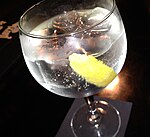
A Manhattan is a cocktail made with whiskey, sweet vermouth, and bitters. While rye is the traditional whiskey of choice, other commonly used whiskies include Canadian whisky, bourbon, blended whiskey, and Tennessee whiskey. The cocktail is usually stirred with ice then strained into a chilled cocktail glass and garnished traditionally with a maraschino cherry. A Manhattan may also be served on the rocks in a lowball glass.
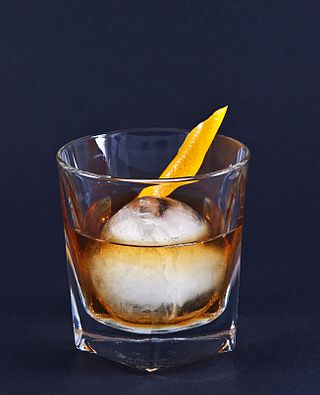
The old fashioned is a cocktail made by muddling sugar with bitters and water, adding whiskey or sometimes brandy, and garnishing with an orange slice or zest and a cocktail cherry. It is traditionally served with ice in an old fashioned glass.
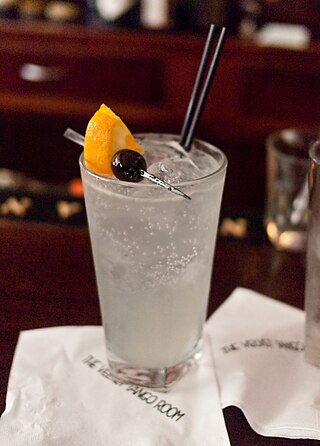
The Tom Collins is a Collins cocktail made from gin, lemon juice, sugar, and carbonated water. First memorialized in writing in 1876 by Jerry Thomas, "the father of American mixology", this "gin and sparkling lemonade" drink is typically served in a Collins glass over ice with a cherry garnish. A non-alcoholic "Collins mix" mixer is produced, enjoyed by some as a soft drink.

Grenadine is a commonly used nonalcoholic bar syrup characterized by its deep red color. It is a popular cocktail ingredient renowned for its flavor as well as its ability to give a reddish or pink tint to mixed drinks. Grenadine is a syrup traditionally made from pomegranate, but may also be made from other fruits such as elder, blackcurrant, raspberry, gooseberry, or commercially sourced natural or artificial flavors.
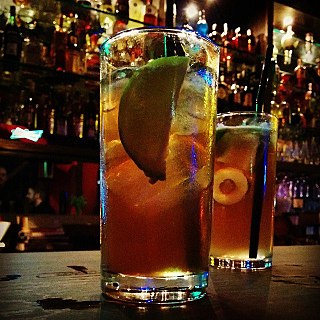
The Long Island iced tea, or Long Island ice tea, is an IBA official cocktail, typically made with vodka, tequila, light rum, triple sec, gin, and a splash of cola. Despite its name, the cocktail does not typically contain iced tea, but is named for having the same amber hue as iced tea.

The daiquiri is a cocktail whose main ingredients are rum, citrus juice, and sugar or other sweetener.

The Singapore sling is a gin-based sling cocktail from Singapore. This long drink was developed in 1915 by Ngiam Tong Boon, a bartender at the Long Bar in Raffles Hotel, Singapore. It was initially called the gin sling.

A Shirley Temple is a non-alcoholic mixed drink traditionally made with ginger ale and a splash of grenadine, and garnished with a maraschino cherry. Modern Shirley Temple recipes may substitute lemon-lime soda or lemonade and sometimes orange juice, in part or in whole. Shirley Temples are often served as an alternative to alcoholic cocktails, as are the similar Roy Rogers and Arnold Palmer. In some regions of the Midwestern United States, the cocktail is referred to as a Kiddie Cocktail, as it is often served to children.

A sour is a traditional family of mixed drinks. Sours belong to one of the old families of original cocktails and are described by Jerry Thomas in his 1862 book How to Mix Drinks.

The Prince of Wales is a cocktail created by Albert Edward, Prince of Wales, who later became King Edward VII. There are several variations of the cocktail, but what they usually have in common is champagne, angostura bitters, sugar, either rye whiskey or cognac, and a liqueur.

The Fine Art of Mixing Drinks is a book about cocktails by David A. Embury, first published in 1948. The book is noteworthy for its witty, highly opinionated and conversational tone, as well as its categorization of cocktails into two main types: aromatic and sour; its categorization of ingredients into three categories: the base, modifying agents, and special flavorings and coloring agents; and its 1:2:8 ratio for sour type cocktails.

A whiskey sour is a mixed drink or shot containing whiskey, lemon juice, and sugar, and traditionally garnished with a cherry or sometimes a lemon wedge. It is a blend of sour, bitter, and sweet flavors. It can be made as a shot or mixed drink, either choice with a base spirit, citrus juice, and a sweetener.
The brandy daisy is a cocktail which first gained popularity in the late 19th century. One of the earliest known recipes was published in 1876 in the second edition of Jerry Thomas's The Bartenders Guide or How To Mix Drinks: The Bon-Vivants Companion:
Fill glass half full of shaved ice. Shake well and strain into a glass, and fill up with Seltzer water from a syphon.

A "fizz" is a mixed drink variation on the older sours family of cocktail. Its defining features are an acidic juice and carbonated water. It typically includes gin or rum as its alcoholic ingredient.
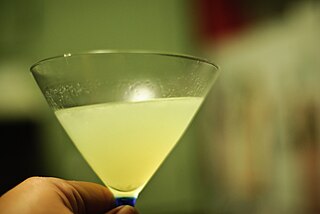
The Last Word is a gin-based cocktail originating at the Detroit Athletic Club in the 1910s, shortly before the start of Prohibition. After a long period of obscurity, it enjoyed a renewed popularity in the cocktail renaissance of the early 2000s after being discovered by bartender Murray Stenson of the Zig Zag Café in Seattle.

The doctor cocktail is a pre-prohibition era cocktail that traces in drink guides to as far back as 1917, when it appeared in Hugo R. Ensslin's Recipes for Mixed Drinks. As originally described the cocktail called simply for Swedish Punsch mixed with lime juice.

A whiskey cocktail is a cocktail that includes whiskey. Although whiskey is often served neat or on the rocks, it is used in many classic cocktails such as the Old Fashioned, Manhattan, and Julep. Some specifically call for Scotch whisky or bourbon whiskey.
A sherry cobbler is a classic American cocktail made with sherry, sugar and citrus. Its origins are not known in detail, but is believed to have originated sometime in the early 19th century. The earliest known mention is from an 1838 diary of a Canadian traveler to the United States, Katherine Jane Ellice, but it did not gain international name recognition until Charles Dickens included the drink in The Life and Adventures of Martin Chuzzlewit.


















